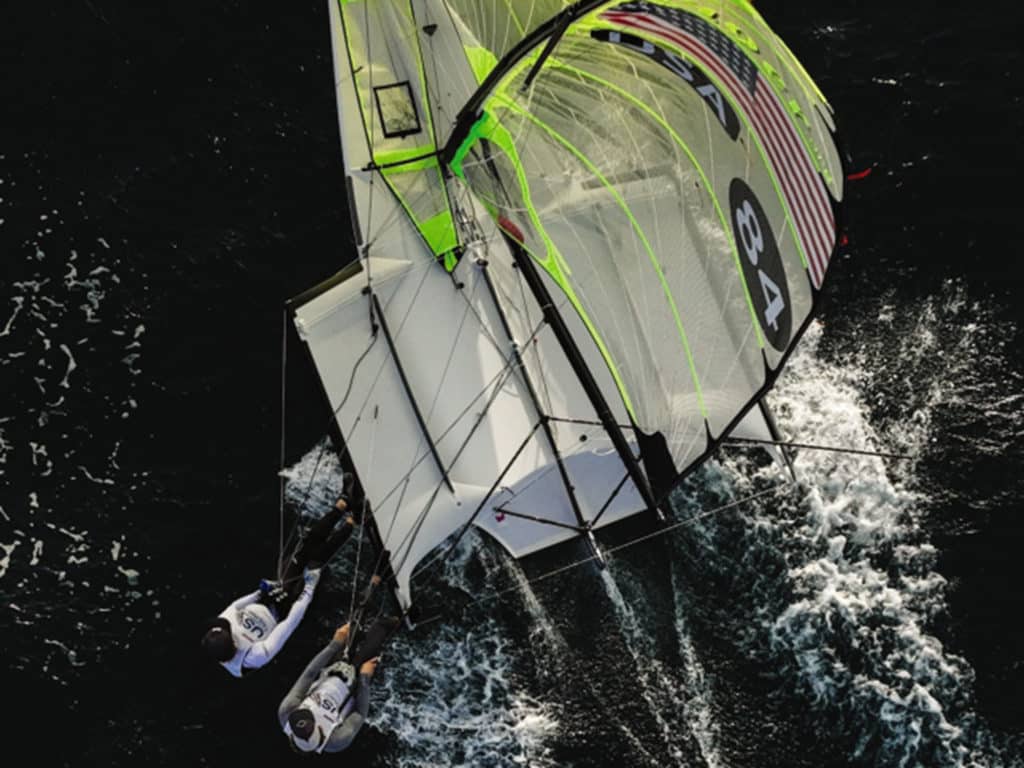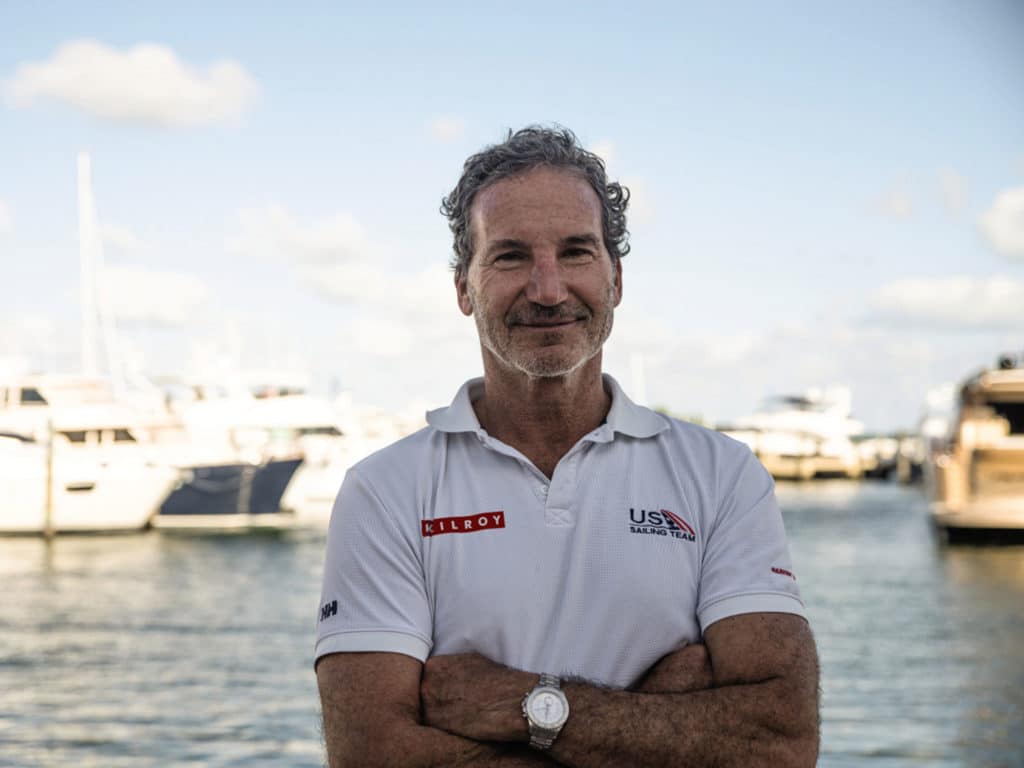
When Team USA left Tokyo empty-handed, we were reminded that Olympic sailing is one corner of our sport that can generate as much controversy—OK, almost as much—as America’s Cup. But Team USA is changing.
Oh, you’ve heard that one before?
Let’s give it a think. Paul Cayard is the latest hopeful to step up as executive director of US Olympic Sailing and talk transformation. He’s taking on a firing-line job with guaranteed slings and arrows, and few guaranteed rewards, and it’s a job that won’t pay what he could be pulling in elsewhere. But once upon a time, Cayard was the kid who took a business degree to prepare himself as a professional sailor. And he studied languages because the work is international. And when he became a top dog on America’s Cup teams, he hauled sails with the boys because that says team. Cayard is Mr. Credibility.
His assessment: “When the Olympic game was bring-your-own, the US kicked butt. Then ISAF changed the rules to allow corporate sponsors, and other countries embraced the change. That was 1989, and it was a quantum shift. Before, the only full professionals were the Eastern Bloc sailors who were ‘in the military.’ The US didn’t match that shift. Until recently, we still played bring-your-own. To go to the ’04 Games in Athens, I spent $250,000, and I could afford that because I had a career under my belt. Our young people today don’t have that luxury as they try to compete against someone like Iain Percy who, as a gold medalist, gets paid that much every year to sail for the UK, with funding through their national lottery.”
More money. More coaching. Yadda, yadda and, of course, that’s all on the agenda. But ask Cayard about practical steps and you get answers. They’re about developing robust structures to support young sailors as they grow, promoting opportunities to sail in Olympic classes, partnering with the college sailing system, and building strong Olympic-classes competition inside the USA.
Let’s take them one at a time.
The AmericaOne Foundation backed Cayard’s America’s Cup bid in New Zealand in 2000, then pivoted to other goals that are paying off now. Cayard says: “We were blessed to have the vision of Larry Finch, Doug Smith and ‘Buddha’ Bob Billingham to pick one piece of the puzzle and tackle it. You need a pipeline of talent, and there’s no switch you can throw to open that spigot. It takes time. We had seen the way other countries were developing youth sailors. That was not happening here, so AmericaOne partnered with US Sailing in 2014 to create Project Pipeline. Along with the Olympic Development Program, that has proven itself with successes at the youth Worlds level. In 2019, we had five golds in nine classes, and we were the top nation. Now we’re building on that. ODP in 2021 had 150 kids benefitting from Olympic-level coaching. We want to grow that number to 250 over the next seven years.”
The unique North American system of college sailing in (mostly) FJs and C420s gets fingered for sucking up talent while developing excellence—but in a limited range. It’s also noted for providing a compelling social experience but not turning out 20-somethings equipped for the complexities of an Olympic campaign. In Cayard’s view, addressing that by adding an optional high-
performance track shouldn’t be a problem at all. “Sailing is the only college sport that goes on all year,” he says. “Every other sport has a season. To me, nine months of tacking and jibing FJs is a waste of talent for top sailors. There should be options.
“We can leave spring sailing as it is, and when people get to Nationals in May—if they’ve spent time the previous year cross-training in a 49er, FX or Nacra—that experience should be an asset. Then they get back into Olympic-class training in the summer with the option of continuing in the fall semester, and we can have an intercollegiate Olympic-classes regatta in Miami at the winter break. After that, it’s back to the familiar college format in spring to prove they haven’t forgotten how to sail FJs.”
Heh. Haven’t forgotten how to sail FJs…
Pulling this off may prove a mite more complicated than described, but we’ll come back to that. And it is important to be clear that, in Cayard’s vision, college sailing proceeds undisrupted. The people who belong in fall-semester college sailing have at it, while some of their team members go off on the Olympic track until the spring semester.
Eventually, the US sailing team might look more like the UK, with its oversupply of up-and-coming youth and its reliance on development squads. Mark Robinson, the UK team’s head of performance, comments: “Most countries would run squads if they could. It’s about having a team that can develop within itself.” Riding the same wavelength, Cayard says: “We’re a country that can build competent squads—our kite sailors are already there—and it is important to build those squads to make us more efficient with time and money. Athletes should train here, not abroad. This is a huge practical step. There are classes where, right now, we don’t have a depth of talent, so it makes no sense for someone looking to get competitive to fly to Kiel Week and finish 47th. That’s time and money wasted. There was a time when you could get great Olympic-class competition here, but not now. We have to rectify that. In Europe, you drive a couple of hours to a weekend regatta, and you’re competing against top sailors from who knows how many countries. We’ve grown from one Olympic-classes regatta in the US to three? Six? That’s a beginning.”
And that beginning provides a point to stop and catch a breath.
Cayard reflects: “It was not a foregone conclusion that I would take this on, but I’m emotionally invested. I am convinced that it is doable. There are these facts to address: An athlete can peak only two or three times per year. There is a science to that, and we need to apply the science. We need a coaching pipeline as well as a sailor pipeline. We need data and data analysis (there was a tech confab at Harken headquarters last fall) because we have to ask, will the best sailors move from the Nacra 15 to the Nacra 17 and blaze their own trail, or will they start from a higher level because we’re doing a better job of telling them what they need to know?

“I foresee a budget 50 percent bigger than in recent years,” Cayard says. “That will begin to provide better support for our frontline sailors. Right now, they spend too much time bartending at fundraisers to pay for coaching. The other component, and this is major, is to pull the trials back to the US. Would Kenny Keefe and I have gone to the 1984 trials if they had been in Holland or Japan? No. Would John Kostecki have gone to his trials if they were in New Zealand? No. And when you go overseas to sail a world championship that is part of your US trials, everything is skewed. You’re not sailing to win; you’re sailing to beat the other Americans. We can do better.”
Thank you, Paul. Now let’s weigh other perspectives regarding one item on your list because there is a long history of people, rightly or wrongly, looking at college sailing as a stumbling block to Olympic development.
Old Dominion University coach Mitch Brindley, who is also president of the Inter-Collegiate Sailing Association, sees “no definite plans for restructuring college sailing to accommodate the Olympic path. I’ve had one conversation with Cayard (at the time of this interview), but I look forward to more. We always try to work in concert with US Sailing’s Olympic efforts. As much as we’d love to sail skiffs and high-performance boats, the money for that is hard to come by. One of the beauties of college sailing is the relatively low cost of entry. That allows us to develop athletes who may not have had opportunities before.”
Per Cayard, an Olympic college track would be a bring-your-own-boat deal, at least for starters. And I don’t want to make it sound as if Brindley and Cayard are butting heads. What I think I hear from them is the bare beginning of a conversation in which the threads are not yet meeting in the middle.
Brindley wants you to know: “College sailing is successful, and we’re growing our number of varsity teams and full-time coaches. They raise the game, whether it’s happening at Tulane or Brown, both of which are relatively new as varsity teams. In any campus sport, only a few students matriculate to the Olympic movement, but with shorter races and more mixed racing, we see Olympic sailing in some aspects moving toward the college format. We’re glad to see them catching up.”
Good stinger, Mitch. And good reader, you will notice he left the door open. Regarding that door, Andrew Mollerus says, “I wish the high-performance track had been around in my time,” meaning his years at Harvard, where he was a sailing team captain and All-American. Mollerus checked in from Marseilles, where he and Ian MacDiarmid were racing a 49er in the waters of the 2024 Games. His take: “Getting our top juniors into Olympic-class boats early is critical. The US is enjoying success at the youth level—thanks in large part to Leandro Spina and ODP—but there is a high attrition rate during and after college. Among all the possible remedies, the high-performance track that Paul proposes is the best solution.”
By way of counterpoint, in talking with college coaches, I encounter concerns about the logistics, including possible travel commitments for sailors who, more often than not, are academic high-achievers. “Just” sailing FJs is already a lot on top of classes and study. But it’s too early for debating because we don’t know what we’re debating beyond objections to the status quo and some big what-ifs. At a granular level, how might it affect teams to have a cadre of their (probably) most capable sailors jumping back into FJs and 420s for spring semester? Mollerus, a Phi Beta Kappa, believes: “The teams would benefit from an influx of lessons learned and technical skills that you don’t necessarily get from college sailing. As for Team USA, it’s impossible to change things overnight, but focusing the program on 2028, as they’re doing, is exactly right. We’re lucky that Cayard is driving this, given his level of respect and clout.”
And that’s where we came in. Among all of Cayard’s proposals for reinventing Team USA, building a high-performance track in college sailing is the most likely to provoke a lively conversation. So, wear your sunscreen. Strap on that PFD when the Y flag is flying. And hey, Paul—no pressure.









